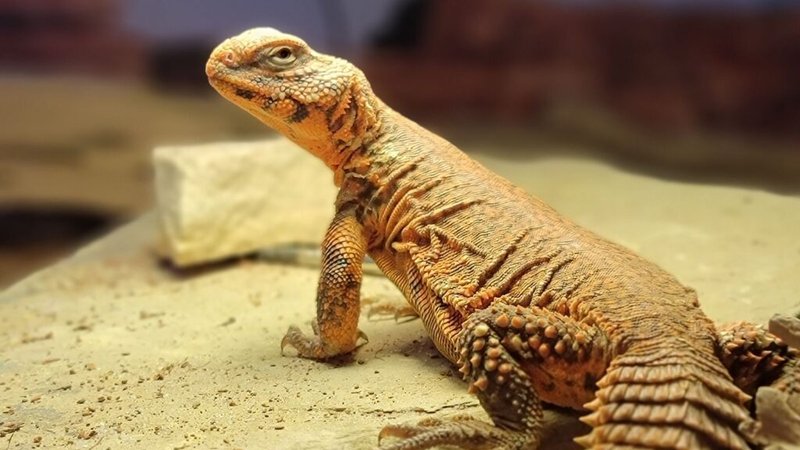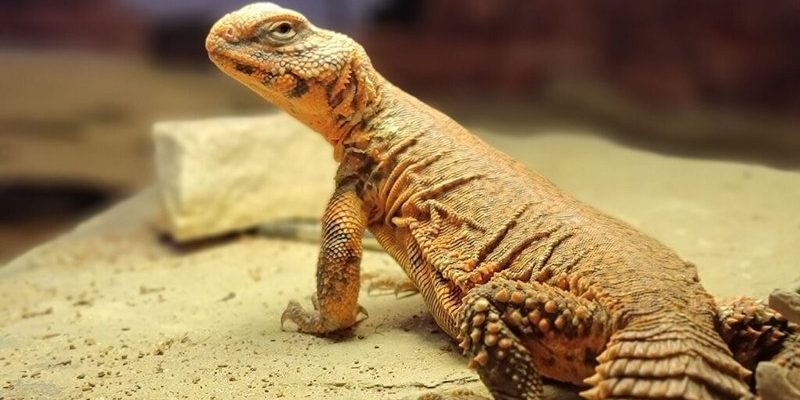
Imagine a lizard that looks like it came straight from a fantasy novel. The Uromastyx, with its spiny tail and captivating colors, has a striking appearance that’s hard to forget. These lizards are not just pretty faces, though—they are fascinating creatures that have adapted to survive in some of the harshest environments on Earth. Found primarily in deserts and dry regions, they’ve developed unique survival skills that make them truly remarkable.
But what exactly sets Uromastyx apart from other lizards? For starters, they’re herbivores in a world dominated by carnivorous reptiles. Their diet consists mainly of leaves, flowers, and fruits, which is a bit unusual compared to most lizards. This dietary choice not only influences their behavior but also plays a significant role in their care if you’re considering one as a pet. So, grab your favorite drink and let’s dive deeper into the life and times of the Uromastyx.
Physical Characteristics
The Uromastyx is known for its distinct appearance. With a stocky body and short legs, these lizards can grow to be anywhere between 12 to 24 inches long, depending on the species. Their skin often sports a range of colors including vibrant yellows, greens, and browns, which help them blend in with their rocky surroundings. One of the most unique features is their tail, which is covered in spines and is used as a defense mechanism against predators. If threatened, they can whip their tail around, delivering a painful jab.
In addition to their physical traits, Uromastyx are equipped with strong limbs that make them excellent burrowers. They create extensive burrow systems in the sand, which provide shelter from the harsh desert sun and help retain moisture. This is crucial for their survival, especially since they thrive in environments where temperatures can soar during the day.
Habitat and Distribution
Uromastyx lizards are predominantly found in regions across North Africa, the Middle East, and parts of Asia. They favor arid, rocky terrains where they can bask in the sun and find food. Their habitat is often a mix of desert landscapes, savannahs, and scrublands. Here, they can easily camouflage with their environment, protecting them from potential predators.
Interestingly, the habitat of the Uromastyx isn’t just about surviving; it’s about thriving in extreme conditions. During the scorching days, they retreat to their burrows to avoid the heat, becoming more active during cooler mornings and evenings. This unique adaptation allows them to manage their body temperature effectively.
Diet and Feeding Habits
As herbivores, Uromastyx have quite the varied diet. They primarily feed on a mix of leafy greens, flowering plants, and fruits. Some of their favorites include dandelions, clover, and various types of cacti. It’s interesting to note that their diet is rich in fiber, which is essential for their digestive health. In the wild, they spend much of their day foraging for food, making them consistently on the move.
Feeding a Uromastyx in captivity requires a bit of planning. A diet rich in leafy greens is essential, and they may also enjoy grated vegetables and occasional fruits. However, it’s important to avoid feeding them too much fruit due to high sugar content. Providing calcium supplements is crucial as well, helping to maintain their bone health. Monitoring their diet is key, as a balanced intake affects their overall health and vitality.
Behavior and Temperament
Uromastyx lizards are known for their calm and generally docile temperament. Unlike some other lizard species that can be skittish or aggressive, Uromastyx tend to be more laid-back. They can become quite friendly with regular handling, making them a popular choice for pet owners who enjoy interacting with their reptiles.
In the wild, Uromastyx are social creatures. They often bask together in groups and communicate through body language and vocalizations. You might even catch them engaging in playful wrestling or territorial displays. This social aspect can also be beneficial when keeping them in captivity, as housing them in pairs or small groups can lead to a happier, more dynamic environment.
Reproduction and Lifespan
Uromastyx typically reach sexual maturity at about two years of age. The mating season often depends on their geographic location, but it usually occurs during the warmer months. Females lay eggs, and depending on the species, a clutch can range from 5 to 20 eggs. After laying, the eggs will incubate for around 60 to 90 days before hatching.
In captivity, if the conditions are right, Uromastyx can live for 10 to 20 years, and some have been known to live even longer. This longevity makes them a long-term commitment for pet owners. Ensuring they have a proper diet, habitat, and health check-ups is essential for a happy, healthy life.
Conservation Status
While some species of Uromastyx are relatively common, others are facing threats due to habitat destruction and the pet trade. As with many reptiles, their populations are vulnerable to climate change and human activities that disrupt their natural habitats. Conservation efforts are underway to protect these unique lizards, but it’s essential for us to be aware of the impact our choices can have.
If you’re considering a Uromastyx as a pet, it’s vital to ensure you’re sourcing your lizard from a reputable breeder or rescue organization that prioritizes the health of the species. By supporting ethical practices, you contribute to the conservation of these fascinating reptiles.
Caring for a Uromastyx
Thinking about welcoming a Uromastyx into your home? Great choice! Caring for these lizards requires some basic knowledge and commitment. First, you’ll need to create an appropriate habitat, which should include a spacious enclosure with plenty of hiding spots, basking areas, and UVB lighting to help them synthesize vitamin D3. Keeping the temperature gradient in mind is crucial, too—make sure they have both hot and cooler areas to regulate their body temperature.
Feeding them is another key part of Uromastyx care. As mentioned, they thrive on a herbivorous diet, so plan on providing a variety of greens and vegetables. Regularly checking their health, including monitoring their weight and activity levels, can help catch any potential issues early. With the right care, you’ll have a happy Uromastyx that thrives!
Table of Quick Facts
| Common Name: | Uromastyx |
| Size: | 12 to 24 inches |
| Habitat: | Deserts, rocky terrains |
| Diet: | Herbivorous (leaves, fruits, flowers) |
| Lifespan: | 10 to 20 years |
| Social Behavior: | Generally friendly, social |
| Reproduction: | Egg-laying |
FAQ
What is the native range of Uromastyx lizards?
Uromastyx lizards are primarily found in the dry and hot regions of North Africa, the Middle East, and parts of Asia. They thrive in arid environments, often residing in rocky areas and deserts where they can easily camouflage and forage for plants.
Are Uromastyx good pets for beginners?
Yes, Uromastyx can be suitable pets for beginners! They are generally docile and friendly lizards that adapt well to captivity. However, it’s essential to educate yourself on their dietary needs and habitat requirements to ensure they thrive in a home environment.
How do you set up a habitat for a Uromastyx?
To set up a habitat for your Uromastyx, choose an appropriately sized enclosure (at least 40 gallons for adults). Provide hiding spots using rocks or logs, and create a temperature gradient with a basking area of around 100°F and a cooler side around 80°F. Don’t forget to install UVB lighting to help them synthesize vitamin D3!
What do Uromastyx eat in the wild?
In the wild, Uromastyx primarily consume a variety of plants, including leafy greens, flowers, and fruits. They have a fibrous diet that helps with their digestion and overall health. It’s important to replicate this diet as closely as possible in captivity.
Can Uromastyx live with other reptiles?
While Uromastyx can be social with their own kind, housing them with other species is generally not recommended. They may not get along well with other reptiles due to different territorial behaviors and dietary needs. It’s best to keep them in a separate enclosure to avoid stress or aggression.
How do you know if a Uromastyx is healthy?
A healthy Uromastyx will be active, alert, and have a good appetite. Regularly monitor their weight and observe their behavior. Any signs of lethargy, a lack of appetite, or unusual stool can indicate health issues, and it’s best to consult a veterinarian if you have concerns.
Do Uromastyx require a lot of water?
Uromastyx don’t require as much water as many other reptiles, as they obtain much of their moisture from their food. However, it’s crucial to provide fresh water for drinking and to keep humidity at appropriate levels. A shallow dish of water in their enclosure is a good idea.
What are the common health issues with Uromastyx?
Common health issues in Uromastyx can include metabolic bone disease, respiratory infections, and dietary deficiencies. Proper care, including a balanced diet and appropriate habitat conditions, can help prevent these issues. Regular check-ups with a vet experienced with reptiles are also beneficial.
How can I breed Uromastyx?
Breeding Uromastyx requires suitable conditions for mating, typically during warmer months. Ensure a healthy male-to-female ratio and observe their courtship behaviors. After mating, females will lay eggs, which should be incubated in a separate, controlled environment to ensure successful hatching.
Are there different species of Uromastyx?
Yes, there are several species of Uromastyx, each with its own unique traits and habitat preferences. Some popular species include Uromastyx aegypticus, Uromastyx ornata, and Uromastyx dispar. Each has different care requirements, so it’s essential to research the specific species you’re interested in.
What should I do if my Uromastyx isn’t eating?
If your Uromastyx isn’t eating, first check their habitat conditions—temperature, humidity, and lighting. Ensure you’re offering a varied diet and avoid overfeeding. If they continue to refuse food for an extended period, consult a vet specializing in reptiles for advice.

